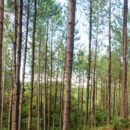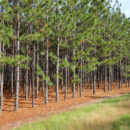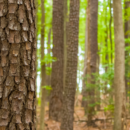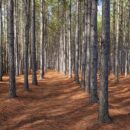FNC News
Site Prep Methods for Pine Plantations
In our last article, we briefly discussed some of the decisions a landowner must make after completing a total harvest operation on their property.
Site preparation involves treating land to improve planting conditions as well as the growth and survival the seedlings. Type and intensity of site preparation varies according to site, species, ground cover, and soils. Choosing appropriate site prep operations is crucial to establishing a thriving pine plantation since the method, intensity, and timing of site preparation operations must suit the specific site.
Bedding: Bedding involves creating a raised bed of soil on which to plant seedlings. It is much like the practice of tilling a garden. This practice is seen most in areas that have poorly drained soils and helps establish the seedlings by keeping the roots above the water line. Upland bedding is also used in some areas and helps by breaking up harder soils to make planting and root establishment easier. It also increases the soil’s ability to retain water.
Chopping (Roller Chopping, Drum Chopping): Chopping is using a bulldozer to pull a large, rolling drum chopper over brush and small diameter trees, to crush woody vegetation. This practice is not as common due to the cost associated with utilizing large equipment.
Ripping (Subsoiling): Ripping opens furrows up to a depth of 15 inches to increase aeration and water-holding capacity of soils, and breaks up root-constricting hard pans or plow-pans and compaction. Tracts that have been grazed typically require a ripping operation.
Chemical Site Prep: This method involves applying herbicides to prepare for planting seedlings. It is the most common site prep method today due to its cost-effectiveness and ability to be tailored to specific site needs. Herbicides are chosen based on factors such as the species to be controlled and soil conditions. Chemical site prep operations may be broadcast by air, usually with a helicopter, or on the ground with a skidder.
Prescribed Burning: Prescribed burning is fire applied in a skillful manner to a tract for a specific purpose, under exacting weather conditions. A site prep burn is used to kill woody and herbaceous vegetation and clean up some of the logging slash left behind at harvest. It is relatively inexpensive when compared to other site prep procedures.
Shearing: Shearing prepares sites by using a bulldozer equipped with a serrated V-blade to severe remaining woody vegetation and stumps close to ground level. This method is used on tracts with a lot of woody vegetation that could not be harvested or removed during the logging operation. Shearing follows the contour of the land to reduce the risk of erosion. Due to the use of heavy equipment, this method tends to be very expensive.
Raking (Root Raking): Raking usually follows shearing and is used to push logging slash and sheared stumps into windrows or piles. A rake blade is typically placed on a dozer with open slats at the bottom of the blade allowing much of the dirt to remain behind while pushing the debris. Windrows are placed along the contour of the land at intervals to help reduce erosion concerns and are then sometimes burned.
Interested in learning more about reforestation? Contact an FNC Forester today to discuss your specific site preparation needs.
More News
Get in Touch




